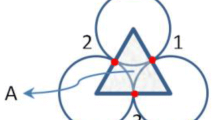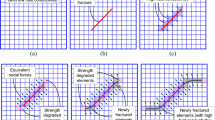Abstract
Introduction
The present study aimed to simulate the interaction between hydraulic fractures and natural fractures using hydromechanical coupling in the bonded particle model using the smooth joint method, followed by sensitivity analysis regarding the angle of approach of the pre-existing fractures relative to the direction of the hydraulic fracture, strength of the natural fractures, and ratio of the in-situ stresses.
Methods
In the present research, the model of hydraulic fracture in a reservoir with natural fractures was assessed by hydromechanical coupling, implemented in the discrete element method, based on the BPM. Considering the discontinuous nature of the current research, the BPM-based PFC2D software was applied to simulate the interaction of hydraulic fractures and natural fractures. At first, the microparameters that correspond to the macroscale characteristics of the rock were identified by comparison with experimental results through repetitive calibration. DEM results were compared with experimental results from uniaxial compressive and Brazilian test scale model testing. Sensitivity analysis was performed in terms of the angle of approach parameters of natural fractures, joint strength, and in-situ stress ratio.
Results
According to the results of the modeling processes, the shape of the time history curves of wellbore pressure was the same for various angles of approach of 30, 60, and 90 degree relative to the vertical direction. Since the hydraulic fracture tended to be grown and propagated in the direction of the least strength, it propagates in the pre-existing fractures without strength or their dilation. The hydraulic fracture breakdown largely depended on the ratio of the in-situ stresses as in a similar state of the maximum principal stress, the value of the minimum principal stress had considerable effects on the fracture propagation pattern. The breakdown pressures of the hydraulic fracture with the increased heterogeneity and ratio of the in-situ stresses decreased in a similar situation of the value of the maximum principal stress.
Conclusion
The modeling results indicated that the hydraulic pressure and onset of breakdown time largely depended on the value of the minimum principal stress, so that the increased minimum principal stress would increase the hydraulic fracture and onset time of fracturing. The hydraulic fracture pattern depended on in-situ stresses, and the higher in-situ stress ratios were associated with the increased length of the fracture experiencing aperture.

















Similar content being viewed by others
References
Abdideh M, Bayrami A, Mahmoodzadeh A (2020) Modeling reference fracture pressures to design hydraulic fracture operations using well logging data. Model Earth Syst Environ. https://doi.org/10.1007/s40808-020-00879-7
Bahaaddini M, Hagan PC, Mitra R et al (2015) Parametric study of smooth joint parameters on the shear behaviour of rock joints. Rock Mech Rock Eng 48(3):923–940
Crouch SL (1976) Solution of plane elasticity problems by the displacement discontinuity method. I. Infinite body solution. Int J Numer Meth Eng 10(2):301–343
Chong Z et al (2017) Numerical investigation into the effect of natural fracture density on hydraulic fracture network propagation. Energies 10(7):914
Cundall PA, Strack OD (1979) A discrete numerical model for granular assemblies. Geotechnique 29(1):47–65
Cundall P (2000) Fluid formulation for PFC2D. Minneapolis, Minnesota, Itasca Consulting Group
Chang M, Huang RC (2015) Observations of hydraulic fracturing in soils through field testing and numerical simulations. Can Geotech J 53(2):343–359
Dahi-Taleghani A, Olson JE (2011) Numerical modeling of multistranded-hydraulic-fracture propagation: accounting for the interaction between induced and natural fractures. SPE J 16(03):575–581
Davarpanah A, Mirshekari B (2019) Numerical modelling of hydraulic fracturing procedure in hydrocarbon Reservoirs. Model Earth Syst Environ. https://doi.org/10.1007/s40808-019-00648-1
Eshiet KI, Sheng Y, Ye J (2013) Microscopic modelling of the hydraulic fracturing process. Environ Earth Sci 68(4):1169–1186
Fjar E, Holt RM, Raaen AM, Horsrud P (2008) Petroleum related rock mechanics. Elsevier.
Furtney J, Zhang F, Han Y (2013) Review of methods and applications for incorporating fluid flow in the discrete element method. In: Proceedings of the 3rd international FLAC/DEM symposium, Hangzhou, China
Geertsma J, de Klerk F (1969) A rapid method of predicting width and extent of hydraulically induced fractures. J Petrol Technol 21(12):1571–1581
Hofmann H, Babadaglia T, Yoon JS, Blöcher G, Zimmermann G (2016) A hybrid discrete/finite element modeling study of complex hydraulic fracture development for enhanced geothermal systems (EGS) in granitic basements. Geothermics 64:362–381
Hubbert MK, Willis DG (1972) Mechanics of hydraulic fracturing.
Itasca C (2008) PFC2D (particle flow code in 2 dimensions), version 4.0. ICG, Minneapolis
Jeffrey R, Vandamme L, Roegiers JC (1987) Mechanical interactions in branched or subparallel hydraulic fractures. In: Low permeability reservoirs symposium. SPE/DOE Joint symposium on low permeability reservoirs, Denver, Colorado, May 1987. https://doi.org/10.2118/16422-MS
Khristianovic S, Zheltov Y (1955) Formation of vertical fractures by means of highly viscous fluids. In: Proceedings ot the 4th world petroleum congress, Rome.
Koshelev V, Ghassemi A (2003) Hydraulic fracture propagation near a natural discontinuity. In: Proceedings of the 28th Workshop on Geothermal Reservoir Engineering.
Katsaga T, Riahi A, Damjanac B (2015) Three-dimensional investigation of hydraulic treatment in naturally fractured reservoirs. In: Proceedings of the 40th Workshop on Geothermal Reservoir Engineering.
Lee H, Jeon S (2011) An experimental and numerical study of fracture coalescence in pre-cracked specimens under uniaxial compression. Int J Solids Struct 48(6):979–999
Lichun J et al (2013) Experimental study on propagation of hydraulic fracture in volcanic rocks using industrial CT technology. Pet Explor Dev 40(3):405–408
Moschovidis Z et al (2000) The Mounds drill-cuttings injection field experiment: final results and conclusions. In: IADC/SPE Drilling Conference.Society of Petroleum Engineers.
Nagel NB et al (2011) Simulating hydraulic fracturing in real fractured rocks-overcjavascript. In: SPE Hydraulic Fracturing Technology Conference. Society of Petroleum Engineers.
Potyondy DO, Cundall P (2004) A bonded-particle model for rock. Int J of Rock Mech and Mining Sci 41(8):1329–1364
Pierce M et al (2007) A synthetic rock mass model for jointed rock. In: Proceedings of the first CA–US rock mechanics symposium, Vancouver, BC.
Potluri N, Zhu D, Hill AD (2005) The effect of natural fractures on hydraulic fracture propagation. In: SPE European formation damage conference. Society of Petroleum Engineers.
Pine R, Cundall P (1985) Applications of the fluid-rock interaction program (FRIP) to the modelling of hot dry rock geothermal enery systems. In: International symposium on fundamentals of rock joints.
Peaceman DW (1977) Fundamentals of numerical reservoir simulation. Elsevier Scientific Publishing Company.
Perkins T, Kern L (1961) Widths of hydraulic fractures. J Petrol Tech 13(09):937–949
Rubin AM (1995) Propagation of magma-filled cracks. Annu Rev Earth Planet Sci 23(1):287–336
Rahman MM, Rahman MK (2010) A review of hydraulic fracture models and development of an improved pseudo-3D model for stimulating tight oil/gas sand. Energ Sources Part A Recovery Utilization Environ Effects 32(15):1416–1436
Rahman MM (2009) A fully coupled numerical poroelastic model to investigate interaction between induced hydraulic fracture and pre existing natural fracture in a naturally fractured reservoir: potential application in tight gas and geothermal reservoirs. In: SPE Annual Technical Conference and Exhibition. Society of Petroleum Engineers.
Renshaw C, Pollard D (1995) An experimentally verified criterion for propagation across unbounded frictional interfaces in brittle, linear elastic materials. In: International journal of rock mechanics and mining sciences & geomechanics abstracts. Elsevier.
Riahi A, Damjanac B, Furtney J (2014) Discrete element modeling of thermo-hydro-mechanical coupling in enhanced geothermal reservoirs. In: Proceedings hirty-EighthWorkshop on Geothermal Reservoir Engineering, Stanford
Shen B et al (1995) Coalescence of fractures under shear stresses in experiments. Journal of Geophysical Research: Solid Earth 100(B4):5975–5990
Sarmadivaleh M (2012) Experimental and numerical study of interaction of a pre-existing natural interface and an induced hydraulic fracture. Curtin University.
Sneddon I, Elliot H (1946) The opening of a Griffith crack under internal pressure. Q Appl Math 4(3):262–267
Settari A, Cleary MP (1984) Three-dimensional simulation of hydraulic fracturing. J Petrol Technol 36(07):1177–1190
Stanchits S, Burghardt J, Surdi A (2015) Hydraulic fracturing of heterogeneous rock monitored by acoustic emission. Rock Mech Rock Eng 48(6):2513–2527
Tarasovs S, Ghassemi A (2012) On the role of thermal stress in reservoir stimulation. In: 37th Workshop on Geothermal Reservoir Engineering.
Tomac I, Gutierrez M (2017) Coupled hydro-thermo-mechanical modeling of hydraulic fracturing in quasi-brittle rocks using BPM-DEM. J Rock Mech Geotech Eng 9(1):92–104
Tomac I, Gutierrez M (2020) Micromechanics of hydraulic fracturing and damage in rock based on DEM modeling. Granular Matt. https://doi.org/10.1007/s10035-020-01023-z
Warpinski N, Teufel L (1987) Influence of geologic discontinuities on hydraulic fracture propagation (includes associated papers 17011 and 17074). J Petrol Technol 39(02):209–220
Yushi Z et al (2016) Experimental investigation into hydraulic fracture network propagation in gas shales using CT scanning technology. Rock Mech Rock Eng 49(1):33–45
Yoon JS et al (2017) Discrete element modelling of hydraulic fracture propagation and dynamic interaction with natural fractures in hard rock. Procedia Eng 191:1023–1031
Yoon JS, Zang A, Stephansson O (2014) Numerical investigation on optimized stimulation of intact and naturally fractured deep geothermal reservoirs using hydro-mechanical coupled discrete particles joints model. Geothermics 52:165–184
Zoback M et al (1977) Laboratory hydraulic fracturing experiments in intact and pre-fractured rock. In: International Journal of Rock Mechanics and Mining Sciences & Geomechanics Abstracts. Elsevier.
Zhou J et al (2008) Analysis of fracture propagation behavior and fracture geometry using a tri-axial fracturing system in naturally fractured reservoirs. Int J Rock Mech and Mining Sci 45(7):1143–1152
Zhou J, Zhang L, Han Z (2017a) Hydraulic fracturing process by using a modified two-dimensional particle flow code-method and validation. Prog Comput Fluid Dyn Int J 17(1):52–62
Zhang L et al (2018) Sensitivity analysis on the interaction between hydraulic and natural fractures based on an explicitly coupled hydro-geomechanical model in PFC2D. J Petrol Sci Eng 167:638–653
Zhou J et al (2017b) Investigation of processes of interaction between hydraulic and natural fractures by PFC modeling comparing against laboratory experiments and analytical models. Energies 10(7):1001
Zhou J et al (2016) Numerical modeling and investigation of fluid-driven fracture propagation in reservoirs based on a modified fluid-mechanically coupled model in two-dimensional particle flow code. Energies 9(9):699
Zhao X, Paul Young R (2011) Numerical modeling of seismicity induced by fluid injection in naturally fractured reservoirs. Geophysics 76(6):WC167–WC180
Author information
Authors and Affiliations
Corresponding author
Ethics declarations
Conflict of interest
On behalf of all authors, the corresponding author states that there is no conflict of interest.
Additional information
Publisher's Note
Springer Nature remains neutral with regard to jurisdictional claims in published maps and institutional affiliations.
Rights and permissions
About this article
Cite this article
Pirhooshyaran, M.R., Nikkhah, M. Hydraulic fracture patterns in fractured rock mass using coupled hydromechanical modeling in the bonded particle model. Model. Earth Syst. Environ. 8, 2277–2290 (2022). https://doi.org/10.1007/s40808-021-01218-0
Received:
Accepted:
Published:
Issue Date:
DOI: https://doi.org/10.1007/s40808-021-01218-0




